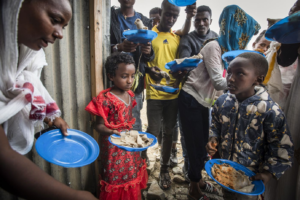by Linda Lyons

WASHINGTON, D.C. — Amid the focus on happiness this week with the release of the 2017 World Happiness report, it’s important to acknowledge the places in the world where it is in short supply. While the three happiest countries are in northern Europe — Norway, Denmark and Iceland — Gallup’s World Poll finds three countries with the highest “suffering” rates in the world in 2016 span three continents. More than four in 10 people rate their current and future lives poorly enough to be categorized as suffering — in South Sudan (47%), Haiti (43%) and Ukraine (41%).
Countries With Highest Suffering in 2016
Gallup classifies people as “thriving” if they rate their current lives a 7 or higher and their lives in five years an 8 or higher on a ladder scale (based on the Cantril Self-Anchoring Striving Scale) with steps numbered from zero to 10, where zero represents the worst possible life and 10 represents the best possible life. People are considered “suffering” if they rate their current and future lives a 4 or lower. The U.N. World Happiness report, in comparison, ranks countries on their happiness and subjective well-being based only on a three-year average of people’s ratings of their current lives from Gallup’s World Poll.
Civil War, Crime and Famine Plague South Sudan
Civil war erupted in South Sudan shortly after it gained independence in 2011; high crime rates and food shortages — that eventually became famine — followed. Suffering rates in the new country increased significantly from 33% in 2014 to 47% in 2016 — the highest level of suffering worldwide.
According to the most recent Gallup data, more than four in 10 (46%) South Sudanese in 2016 report having money or property stolen in the past 12 months, the second-highest percentage in the world after Uganda, and one in four, 24%, have been assaulted, reflecting crime rates that are among the highest in sub-Saharan Africa. And last month, the United Nations declared a famine in two sections of the country while warning that half of the population of South Sudan is facing starvation. Because of the dangerous conditions, emergency relief agencies struggle to deliver food and water to the most desperate areas. In 2016, seven in 10 South Sudanese say they did not have enough money to buy needed food for themselves or their families — an increase of nine percentage points from 2015 (61%).
Haitian Suffering Has Barely Abated Since the 2010 Earthquake
Even before Hurricane Matthew ravaged Haiti in late 2016, the small Caribbean nation was already in deep distress, with more than four in 10 Haitians (43%) rating their lives poorly enough to be considered suffering in recent years (just 3% are deemed thriving). Long recognized as the poorest country in the Americas, Haiti is prone to natural disasters that put further stress on its infrastructure and vulnerable population. A devastating earthquake in 2010 triggered a major cholera epidemic that put intense pressure on Haiti’s already fragile healthcare system. Even before the recent hurricane, satisfaction with the availability of quality healthcare had dropped to a new low of 9%.
The 2010 earthquake further exacerbated the scarcity of affordable housing in Haiti. Six years later, just 17% of Haitians told Gallup that they are satisfied with the availability of affordable housing in the city or area where they live. Those figures have not likely improved since Hurricane Matthew struck the island last October; according to the U.N. Office for the Coordination of Humanitarian Affairs, the storm left nearly 140,000 Haitians homeless.
Ukraine’s Suffering Is the Third Highest in the World
Ukraine is the only European country near the bottom of the World Happiness rankings this year — and the 41% of the population that is considered suffering is the highest Gallup has recorded among post-Soviet states; fewer than one in 10 Ukrainians (9%) are thriving.
The ongoing conflict in eastern Ukraine between Ukrainian and Russian-backed separatist forces have further damaged already poor economic growth in the nation. A solid majority of Ukrainians (57%) believe their personal standard of living is getting worse. Nearly half of Ukrainians (46%) say there were times in the past year when they did not have enough money for food for themselves or their families — the highest figure Gallup has ever recorded for Ukraine and one of the highest in all Europe.
Bottom Line
Not surprisingly, all three countries fall toward the bottom of the U.N. World Happiness rankings: Ukraine is No. 132, Haiti comes in at No. 145 and South Sudan is No. 147. These nations’ low life evaluations will only improve with an end to conflicts, an increase in economic growth, and good governance that is focused on upgrading and enriching the lives of every resident.
The data in this article are available in Gallup Analytics.
Survey Methods
In Haiti, results are based on face-to-face interviews with 504 adults, aged 15 and older, conducted May 18-26, 2016. In Ukraine and South Sudan, results are based on face-to-face interviews with 1,000 adults each, aged 15 and older, conducted in Ukraine June 1-July 15, 2016, and in South Sudan April 14-May 27, 2016. Because of insecurity reasons, geographic exclusions represent about 44% of the estimated national population in South Sudan. Exclusions for similar reasons in Ukraine were 10% of the population in 2014 and 2% in 2015 and 2016. For results based on the total sample of national adults, one can say with 95% confidence that the maximum margin of sampling error ranges from ±3.8 to ±5.1 percentage points. The margin of error reflects the influence of data weighting. In addition to sampling error, question wording and practical difficulties in conducting surveys can introduce error or bias into the findings of public opinion polls.
For complete methodology and specific survey dates, please review Gallup’s Country Data Set details.
Learn more about how the Gallup World Poll works.




